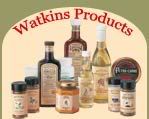Watkins Tip #10
WATKINS ORIGINAL DOUBLE-STRENGTH VANILLA was introduced to our product
line in 1895 and uses Premium-grade Madagascar Bourbon vanilla beans.
These are considered the best vanilla beans in the world and are grown
on the island of Madagascar off the coast of Africa. This
labor-intensive crop is of such high quality that a single bean can retail for more
than $3 (U.S.).
Vanilla is the world's third most expensive spice behind saffron and
cardamom. Every flower must be hand pollinated and since the flower only
lasts for 1 day or less, the crop must be continually inspected for
flowers, the plant only grows if a certain mushroom is nearby, the pods
ripen after 9 months, and the beans must be alternately placed in the sun
and inside each day for several months.
WATKINS ORIGINAL DOUBLE-STRENGTH VANILLA is our 'flagship' product.
When many customers think of Watkins, they think of vanilla. And the
vanilla they are wanting, like their grandmother and great-grandmother used
to use, is the Original Double-Strength - not the pure vanilla.
-----
WATKINS ORIGINAL DOUBLE-STRENGTH VANILLA is:
* Premium-grade Madagascar Bourbon vanilla beans: For full, rich flavor.
* Extremely concentrated
* Bake-proof/freeze-proof: Flavor won't dissipate when making ice cream or foods baked at high temperatures.
* Low alcohol: Only 8 1/4 % versus pure vanilla extract which contains 35% alcohol and can carry away delicate flavor components under high heat.
-----
WATKINS ORIGINAL DOUBLE-STRENGTH VANILLA was awarded the Grand Prize
with Gold Medal for Highest Quality at the International Exposition,
Paris in 1928.
-----
Watkins ORIGINAL Double-Strength Vanilla VS. Watkins PURE Vanilla
Although both contain real Madagascar Bourbon Vanilla extract, Watkins
Original Double-Strength Vanilla is made with considerably less alcohol
and is fortified with stabilizers which make it more effective for
baking and freezing. Watkins Pure Madagascar Bourbon Vanilla extract is
better used in recipes that do not require baking or freezing, such as
adding to whipped cream, butter, cereal, or a favorite beverage.
MEXICAN VANILLA:----------------
Mexican Vanilla must be purchased with caution, if at all. Although
Mexican vanilla beans may be high quality, the vanilla extract produced
there rarely is.
A recent study showed that as many as 42% of bottled vanilla samples
from Mexico contained coumarin which comes from the tonka bean, not the
vanilla bean. Coumarin is highly toxic in large doses, can cause liver
and kidney damage, and has been used in rat poisons, as it causes
internal hemorrhaging. The amount of coumarin in a single two-ounce bottle of
Mexican vanilla could kill someone and Mexican labeling laws do not
require the declaration of ingredients such as coumarin, so you don't know
what you're getting. Considering that Mexico barely produces enough
vanilla for its own use, and that real vanilla, no matter its origin, is
expensive, it's highly unlikely that the bargain-priced bottles of
vanilla found in Mexican souvenir shops are really vanilla.
HISTORY:--------
The Aztecs originally discovered vanilla, which is a species of
climbing orchid, and cultivated it as a crop. When Cortez came to Mexico
around 1510 AD, he was offered a drink by the Emperor Montezuma which was a
chocolate drink flavored with vanilla. Cortez was impressed and took a
supply of vanilla back to Spain, despite the Aztecs attempts to keep
the source a secret, and vanilla soon became a favorite and exclusive
spice for the Aristocrats and Royalty of Europe.
From 1510 AD until 1848, Mexico had a monopoly on the cultivation of
vanilla. Nowhere else in the world was it found possible to grow vanilla
beans. The plant could grow and it would flower, but no beans would
grow. In 1836 a botanist discovered the secret of pollinating the flower
and in 1841 a 12-year-old slave on Bourbon Island found a quick way of
hand-pollinating, which is still used today. In 1848, on Bourbon Island,
the first production of vanilla in history occurred outside of Mexico.
In 1871 Madagascar started production and is now the world's major
producer of vanilla.
Mexico now barely produces enough vanilla for its own use.
-----
Cocoa-Cola is the world's major consumer of vanilla and when they
introduced "New Coke" in 1985, which contained no vanilla, the economy of
Madagascar crashed. In 2000, Madagascar suffered a typhoon followed by
political problems and bad weather and by 2004 the price of vanilla was
up to $250 a pound. More recently the price is back down to about $20
per pound.
USAGE:----
That old, traditional, old-fashioned flavor of baked goods that
everyone loves came mostly from the Watkins Original Double-Strength Vanilla.
Using this vanilla in all of your baking will return your tastebuds to
the good ol' times of great tasting baked goods and other items that
use vanilla.
-----
This vanilla is "double-strength" so you can use half as much as the
recipe calls for. Or, if you like vanilla as much as we do, use the same
amount as the recipe calls for and get an extra wonderful vanilla
flavor.
-----
With a Qtip, rub Watkins Vanilla on a toothache or on a teething baby's
gums to ease the pain.
-----
Make a Black Forest sauce for ice cream by adding 1 teaspoon Watkins
Cherry Extract and 1 teaspoon Watkins Vanilla Extract to 1 cup Chocolate
Syrup.
-----
If you'd like the flavor of a milk shake without the ice cream, pour a
glass of milk, add 1/4 - 1/2 teaspoon of Watkins Vanilla, and a little
sugar or sweetener to taste. My Mom used to love this, especially
when dieting. It is also good in warm milk. If you have an espresso
machine, you can just steam the milk.
----
Add a little Watkins Vanilla to your coffee grinds when brewing your
coffee, or add a little Watkins Vanilla & Watkins Cinnamon to the grinds
and you will have a nice cafe au lait. If your coffee is already
brewed, you can add just a 1/4 tsp of Vanilla right into the cup.
If you enjoy all those creamer products on the market, you can add skim
milk, low fat milk, regular milk, half & half or cream, and add a touch
of vanilla, and your favorite sweetener.
----
It has been said that people crave chocolate or find 'comfort' in their
chocolate and that it is actually the vanilla in the chocolate that
people are seeking. In aromatherapy vanilla is a comforting scent.
-----
If you want to make your house smell comforting and welcoming, heat
some water with just a touch of vanilla in a pan on the stove. It will
permeate your home. I have also added a little cinnamon, cloves, allspice
and or nutmeg - Watkins, of course!
Also, you can put a small amount of Vanilla in a jar lid and place it
on top of the refrigerator, there will be a slow release of Vanilla
scent, due to the warm air coming from the back of the fridge.
----
Around the turn of the twentieth century, women would put a bit of
Vanilla behind each ear as cologne, when their honeys came a-courtin'! I
wonder if this started with Watkins Vanilla?! While we could still use
our Vanilla for those courting purposes, Watkins has made it into a
wonderful cologne - its the only scent Jan wears!
----
When using a cake mix from a box, you can add a little Watkins Vanilla
to perk up the flavor!
----
A very simple icing for cakes or cinnamon rolls or even sweet quick
breads: 1 package of softened Cream Cheese, about 2 cups of confectioners
sugar or more if needed, 1 tsp Watkins Vanilla. If it gets too thick
you can add a few drops of milk at a time until its the desired
consistency.
----
A family tradition in our family is to make a simple syrup for
pancakes, waffles and french toast. In a small sauce pan put 1/2 cup water, 1
cup sugar, and bring to a boil, heat until the sugar is completely
dissolved. Remove from heat, then add 1 tsp Watkins DS Vanilla. This is
Jan's favorite syrup!
-----
With a Qtip, put a drop or two of Watkins Vanilla on a COLD lightbulb.
When you turn the bulb on, the scent of vanilla will permeate the room.
I would not do this on any but incandescent bulbs - NOT halogen or
fluorescent.




0 Comments:
Post a Comment
<< Home